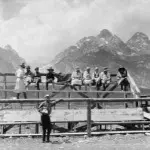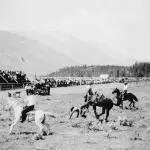The Elbo Ranch was located near the current Climber’s Ranch to the Cottonwood Creek pullout. Lining both sides of the road, this ranch had modest beginnings. The origin of the name and spelling of “Elbo” is unknown, it appears as both “El-Bo” and “Elbo.” James H. “Jimmy” Manges filed a claim for 160 acres under the Homestead Act of 1906 in 1911. Manges cleared 42 acres of land and grew barley, timothy hay and wheat. Like most other homesteaders in the area, growing wheat was a short-lived practice as it was expensive and tedious work. Manges worked for the Wort family, who owned the Wort Hotel in the town of Jackson, chopping firewood in the winter months to bring in some cash. According to A.E. Kendrew, Manges told him that chopping the firewood allowed him to stay warm in his summer clothes.
The location of Manges’ homestead proved to be a very difficult area to cultivate. The work was extremely hard and the soil was ill-suited for crops. With little water for irrigation, it took Manges nearly six years to clear and plant only 42 acres of land. Chester Goss, a Californian, moved into the valley to invest in commercial development and began to purchase homesteads near Jenny Lake. When Goss was interested in his land in 1926, Manges was all too eager to leave. Goss paid just $6,325.00 for the property, which to Manges was a small fortune.
Chester Goss had big plans for the area. When he combined Manges’ 160 acres to those he had already purchased, Goss had amassed 423 acres of land. He called it the Elbo Ranch and quickly began construction. While it was self-described as a dude ranch, the Elbo was anything but. It had a store, gas station, rodeo grounds, racetrack, baseball diamond, grandstands and concessions. There were small cabins and cottages for tourists to spend the night, with several different types available. These cabins boasted running hot water, showers, bathtubs and electricity. These modern comforts were unheard of in the earlier dude ranches. The wealthier socialites from the big cities back east were putting pressure on the ranches in Jackson Hole to make improvements for their personal comfort. For a short time there was even a billboard proclaiming the Elbo Ranch as the “Home of the Hollywood cowboy!” This was soon taken down as it detracted from the natural scenery. This ranch was much more in line with the popular trend of roadside cabin camps, designed for families and individuals with personal vehicles. The idea was to come for a night or two, and be entertained by all of the various activities.
In 1929, Chester Goss sold to the Snake River Land Company, who saw this ranch as a serious threat. It was located in valuable land, directly under the Teton Range and it was an eyesore. The commercialized development was something that John D. Rockefeller, Jr. was working very hard to prevent. Once he was able to purchase this property, most of the commercial activities stopped immediately. During the 1930s, the ranch was used to house National Park Service employees until the completion of new housing in the Beaver Creek Administrative Area located just to the south. The Administrative Area served as park headquarters until 1958 when headquarters was relocated in Moose. The original headquarters cabin, known as “Beaver Creek #10” still exists. Later in 1942, with property was reopened as a true dude ranch to encourage the use of the Jenny Lake concessions. The dude ranch operated under the leases of Harry Espenscheid and later Kate Starratt until 1958. At this time Starratt’s lease was moved across the park to the old Ramshorn Ranch, near Kelly. She moved her operation and renamed the Ramshorn as the Elbo Ranch. This would later be colloquially known as the “second” Elbo Ranch. The property would later house the Teton Science Schools, and today it is known as their Kelly Campus.
In 1970, the remaining buildings and structures of the original Elbo Ranch were torn down and removed. Only the Manges cabin remains today, a quiet reminder of the vibrant history this area once had. The only other remnant of this ranch is the racetrack, which is visible from above with satellite imagery.
TIMELINE
August 11, 1911: James H. “Jimmy” Manges files a claim for 160 acres under the Homestead Act of 1906.
1911: Manges built a small cabin that still stands today. This cabin is known for being the first two-story log structure in the valley.
1911-1917: Manges clears 42 acres of land. He cultivates barley, timothy hay, and wheat.
1926: Chester Goss & The Elbo Ranch Partnership purchase land from Manges. This parcel was included in Goss’ other land purchases in the area, a total of 423 acres.
July 1926: The Elbo Dude Ranch is established.
1929: Sold to Snake River Land Company for $64,000.00
1930s: National Park Service employee housing.
1942: Property leased as a dude ranch by Harry Espenscheid.
1945-7: Property leased again as dude ranch by Kate Starratt.
1958: Lease moved to the Ramshorn Ranch by Kelly. This became known as the “second” Elbo Ranch and is the present location of the Teton Science Schools Kelly Campus.
1970: Remaining buildings and structures in original location torn down and removed. The Manges two story log cabin remains.
Text by Samantha Ford, Director of Historical Research and Outreach



